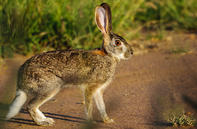
Name
Scrub Hare (Lepus saxatilis)
Appearance
Scrub hares are the most common Lagomorphs in the Lowveld. They live above the ground and do not make use of warrens in the way rabbits do. During the day scrub hares hide out in thick undergrowth vegetation. While sleeping they flatten themselves and the vegetation where they have been lying typically takes the shape of their bodies.
Consequently, the ‘dens’ of scrub hares are known as ‘forms’. Because scrub hares live above the ground and have no ‘safe-house’ to escape into when pursued by predators, as rabbits would have, they are equipped with long powerful legs for running and long ears for enhanced hearing.
Their young, known as leverets, are extremely precocial (fully furred, eyes open and can move from birth) as they need to be able to escape danger immediately on being born. Remarkably, leverets will be totally independent of their parents within one month. The young of rabbits, known as kittens, are typically altricial (eyes closed, helpless and reliant on parental care) as they have the safety of a warren in which to develop after birth. By Megan Emmett
Scrub Hare Diet
The scrub hare is herbivorous and feeds on short, green grasses grown in the bushveld plains of South Africa. In times of scarcity, the hares will also eat leaves, stems and rhizomes of dried grass.Scrub Hare Breeding
Breeding occurs between September and February in South Africa, but they can breed throughout the year. Between one to three leverets are born per litter, with triplets being more likely during a rainy season.Scrub Hare Behaviour
The scrub hare is solitary in nature, however, females in oestrus are often seen accompanied by several males.Where Are Scrub Hare Found
The preferred habitat of the scrub hare is scrub bushveld, tall grasslands and savannah. They are distributed across South Africa, except forests, coastal desert regions and drier north-western parts of the Northern Cape.Field Notes
When scrub hares flee from danger, they are able to reach speeds of 70 kmph. They run in an irregular zigzag manner, which makes it difficult for the predator to follow.
They may even allow an insistent pursuer to gain on them and then at the last moment diverge causing the predator to overshoot and thus have to abandon the chase. At night if scrub hares are caught in the headlights of a vehicle, they may instinctively employ this strategy and continuously flee down the road possibly deflecting at seemingly the last moment.
Often they get tunnel vision from the lights and can’t see where to dart off to so they keep following the illuminated area. It is always the most sensitive thing to dip your headlights and slow down to allow scrub hares to move away. By Megan Emmett
 Scrub hares are vegetarians and eat grass, roots and tubers, which are digested by a hindgut fermentation system meaning all their food is d...
Scrub hares are vegetarians and eat grass, roots and tubers, which are digested by a hindgut fermentation system meaning all their food is d... Learning about the mammals of South Africa is now so much easier for all South Africans - SouthAfrica.co.za is an excellent source of inform...
Learning about the mammals of South Africa is now so much easier for all South Africans - SouthAfrica.co.za is an excellent source of inform...